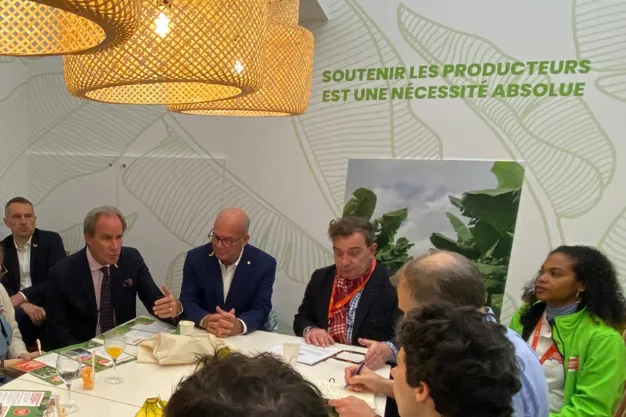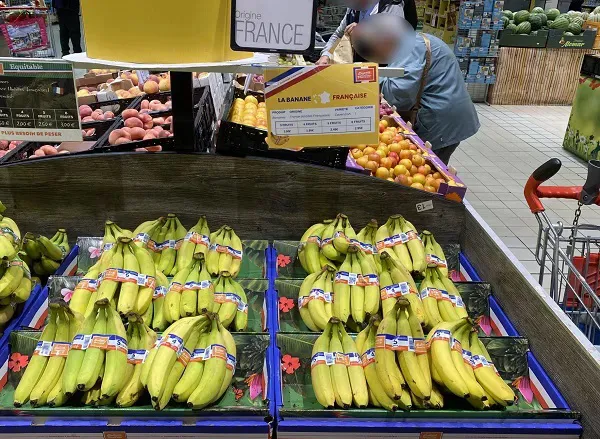"The Union of Guadeloupe and Martinique Banana Producers (UGPBAN) took part in the 60th edition of the International Agricultural Show in Paris under the theme: 'French bananas on the front line again'. The goal was to draw attention to the difficulties that the French banana sector has been experiencing for several years, including climate hazards, sanitary pressure, falling production (amplified by production costs that have risen by almost 40% since 2018) and unfair competition. Producers have been sounding the alarm for nearly 18 months. Pierre Monteux, director of UGBPAN, looks back at the situation, the demands from the sector and the French government's recent announcements."
 © UGPBAN
© UGPBAN
Drop in production and "catastrophic" cash flow
Surface areas remain stable (8,130 hectares), but yields have been declining: 15,000 tons less in 2023 than in 2022. In 10 years, French banana production has fallen by 30%. "Today, we market just 185,000 tons, compared with 250,000 tons 15 years ago. If we lose 15,000 tons at a selling price of 800€/ton [863 USD/ton], with 70% of fixed costs, we end up with a cash flow deficit of nearly 8 million euros [8.6 million USD]."
The reason for this drop in production is the notorious Black Cercosporiosis (caused by the Mycosphaerella fijiensis Morelet fungus), which impacts both yields and fruit quality. "We are the only banana producers in the world to combat this fungus without aerial treatment," explains Pierre Monteux. The growing sanitary pressure is accentuated by a restriction in the number of authorized molecules (only 3 today, compared with 9 in 2019). The increasingly recurrent weather events have also been impacting the already fragile sector. Tropical storms (Fiona in September 2022 and Bret in June 2023) have caused heavy losses in banana plantations, a long dry spell (2020-2021) has slowed down fruit swelling, cool temperatures (winter 2022-2023) and abnormally heavy rainfall (autumn 2022) have favored the development of the fungus.
 The French banana market totals 740,000 tons. It is supplied by three major production zones: the ACP countries (Africa, Caribbean, Pacific), which account for 40% of the market, Latin America (Ecuador, Costa Rica, Colombia) 38% and the West Indies 22%. Banana production in Guadeloupe and Martinique totals 185,000 tons: 55,000 tons for Guadeloupe and 130,000 tons for Martinique, 90% of which is destined for the French market.
The French banana market totals 740,000 tons. It is supplied by three major production zones: the ACP countries (Africa, Caribbean, Pacific), which account for 40% of the market, Latin America (Ecuador, Costa Rica, Colombia) 38% and the West Indies 22%. Banana production in Guadeloupe and Martinique totals 185,000 tons: 55,000 tons for Guadeloupe and 130,000 tons for Martinique, 90% of which is destined for the French market.
Competition from Latin America: "2024 looks complicated"
"2024 promises to be a complicated year," according to Pierre Monteux. "Although the beginning of the year was rather positive, negotiations with supermarkets have been difficult, and they will accept a lower price. The progress made in 2023 (7-8% increase) will certainly be reversed this year. Producers therefore need the support from French public authorities." As the director of UGPBAN points out, the European market is "flooded by dollar bananas."
The problem also lies in social and environmental standards, which differ from those imposed on producers in Guadeloupe and Martinique. Latin American bananas benefit from a number of advantages: near absence of customs duties, easier use of phytosanitary products (French producers use 10 times less phytosanitary products per hectare than producers in Costa Rica, 9 times less than in Cameroon and 8 times less than in Panama), "hyper-competitive" labor costs, and the possibility of aerial treatment, a solution that is currently banned in Europe, although it is very effective in combating banana black rot.
"Agro-environmental measures that cost a lot of money"
Crop rotation, grassing of banana plantations, mechanical weeding, eco-pasturing… Since 2008, the French banana sector has been committed to virtuous production methods. This agro-ecological transition was achieved thanks to the three successive Sustainable Banana Plans. "We have reduced the use of phytosanitary products by 83% in 15 years, and we are one of the few French banana growers to have met the objectives of the Ecophyto plan. However, the implementation of these growing methods costs a lot of money. For example, replacing the use of herbicides with mechanical weed management in banana plantations has generated a cost 4 times higher per hectare, from 1,000 to 4,000 euros [1,078 to 4,313 USD] per year, without even being able to obtain an increase in value in terms of sales."
What is the French government announcing?
"Some announcements have been made." On the sidelines of the International Agricultural Show, the French president and the ultramarine agricultural sectors met at the Elysée Palace after months of discussions. "In the end, our demands were met with a positive response," explains Pierre. The announcements include 11 million euros [12 million USD] in emergency aid and a simplified crop insurance scheme. Other government pledges included support for the use of drones in the fight against Black Cercosporiosis, "a proven, reliable solution that would improve labor conditions and reduce environmental impact," as well as support for NGT, enabling the cultivation of varieties tolerant to Black Cercosporiosis and thus a return to volumes close to 250,000 tons. However, this will generate "intense debate in the trilogue that will open in a few months' time at the European level."
